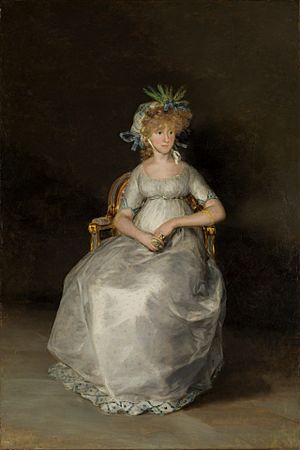The Countess of Chinchon facts for kids
Quick facts for kids The Countess of Chinchon |
|
|---|---|
| Spanish: La Condesa de Chinchón | |
 |
|
| Artist | Francisco Goya |
| Year | c. 1800 |
| Medium | Oil on canvas |
| Dimensions | 216 cm × 144 cm (85 in × 57 in) |
| Location | Museo del Prado, Madrid |
The Countess of Chinchon is a famous painting created around 1800 by the Spanish artist Francisco Goya. It is an oil painting on canvas and can be seen today at the Museo del Prado in Madrid, Spain. The painting shows María Teresa de Borbón, 15th Countess of Chinchón. She was encouraged by Queen Maria Luisa of Parma to marry Manuel de Godoy, who was the Prime Minister at the time. This marriage was for political reasons, not love. It's important to know that this painting is not of the more famous Countess of Chinchón, who gave her name to the cinchona plant. That plant was used to make quinine, a medicine for fever.
Contents
Who Was the Countess of Chinchón?
Maria Teresa of Bourbon y Vallabriga (1780–1828) was a very important lady. She was the Countess of Chinchón and the Marquis de Boadilla del Monte. Her parents were Infant Louis Antoni Bourbon and Maria Teresa de Vallabriga y Rozas. Her father was a prince, but his marriage was not fully approved by the king. Because of this, her father was sent away from the royal court by King Charles III, his brother.
Maria Teresa was only five years old when her father passed away. She and her younger sister were then raised in a monastery in Toledo. When she was 17, a new king and queen, Charles IV and Maria Ludwika, decided she should marry. They chose Manuel Godoy, who was the most powerful man in the court.
A Royal Marriage for Power
Manuel Godoy was the Prime Minister, meaning he was in charge of the government. The Queen wanted him to marry Maria Teresa. For Godoy, marrying a cousin of the king was a huge honor. It made him an official member of the royal family.
Thanks to this marriage, the Countess Maria Teresa got back many special rights. These rights had been lost because her father had been sent away from court. She could now use the royal Bourbon name and coat of arms again. She became one of the most important women in Spain, second only to Queen Maria Ludwika herself.
Goya and the Countess's Family
The Countess's parents loved art very much. They supported many talented painters, writers, and musicians. Goya was one of the artists they helped early in his career. Their support was very important for Goya to become a famous portrait painter.
Goya's Early Works
From 1783 to 1784, Goya stayed with the Countess's family. He painted many artworks for them. One famous painting is called The Family of Infant don Luis. In this painting, Maria Teresa is shown as a young girl watching Goya paint. Goya also painted Maria Teresa when she was a few years old, dressed in a fancy outfit. He likely painted her again around the time of her wedding.
See also
- List of works by Francisco Goya
- Chinchón
- Count of Chinchón
- In Spanish: La condesa de Chinchón (cuadro) para niños

